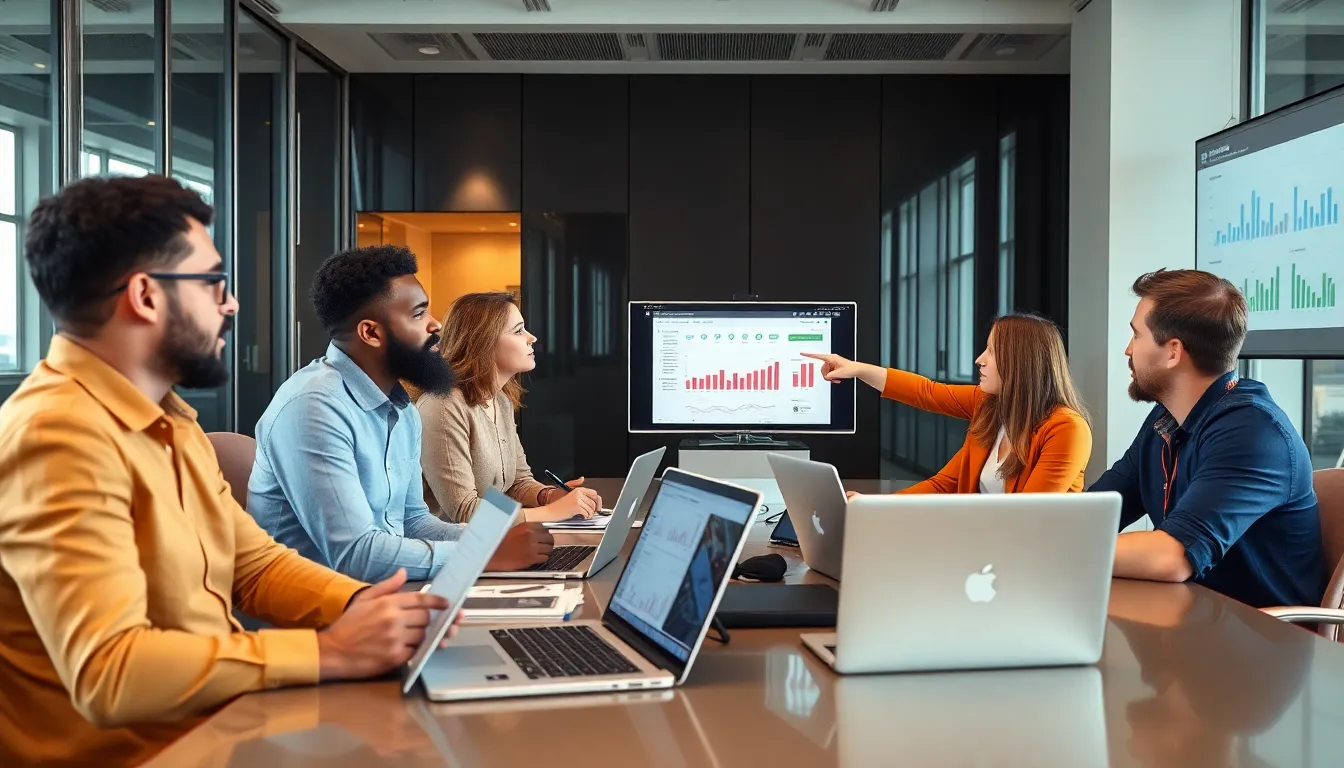In today’s fast-paced world, understanding the nuances of events can make all the difference. Event insights provide valuable data that helps organizers enhance experiences, streamline logistics, and boost attendee engagement. By analyzing trends and feedback, event planners can tailor their strategies to meet the ever-evolving needs of their audience.
With the right insights, organizations can transform ordinary gatherings into memorable experiences. Whether it’s a corporate conference, a music festival, or a community gathering, leveraging data allows for informed decisions that resonate with participants. This article delves into the significance of event insights and how they can elevate the overall impact of any gathering.
Table of Contents
ToggleUnderstanding Event Insights
Event insights consist of actionable data that helps organizers enhance gatherings, improve attendee experiences, and address logistical challenges. These insights stem from various sources, including attendee feedback, participation metrics, and trend analysis.
What Are Event Insights?
Event insights refer to data and analytics that provide a deeper understanding of attendee behavior, preferences, and needs. They encompass survey responses, registration trends, engagement statistics, and social media interactions. By analyzing these data points, organizers can gain a clearer picture of what resonates with their audience and make necessary adjustments to future events.
Importance of Event Insights
Event insights play a crucial role in shaping successful gatherings. They allow planners to:
- Enhance Experiences: By understanding attendee preferences, organizers can tailor activities that align with interests.
- Streamline Logistics: Data-driven decisions improve venue selection, scheduling, and resource allocation, reducing potential issues.
- Increase Engagement: Insights into attendee behavior inform strategies for boosting interaction, leading to elevated satisfaction levels.
- Optimize Marketing Efforts: Analyzing registration trends helps identify effective promotional channels and messaging that resonate with target demographics.
- Drive Continuous Improvement: Leveraging feedback fosters an iterative process, ensuring each event builds on past experiences and meets evolving audience expectations.
Incorporating these insights into planning processes transforms standard events into memorable experiences.
Types of Event Insights

Event insights can be categorized into two primary types: quantitative insights and qualitative insights. Each type offers unique perspectives that help event planners enhance their strategies.
Quantitative Insights
Quantitative insights provide measurable data derived from various metrics. These metrics include:
- Attendance Numbers: Tracks the total number of participants at an event, allowing planners to assess popularity.
- Registration Trends: Analyzes patterns in registration over time, indicating interest and potential future attendance.
- Engagement Statistics: Measures interaction levels during the event, such as session participation and networking activity.
- Survey Responses: Collects numerical ratings on aspects like speaker quality and overall satisfaction.
These insights enable event organizers to identify trends and evaluate performance based on hard data, ensuring informed decisions to improve future events.
Qualitative Insights
Qualitative insights offer deeper understanding through subjective feedback. Key components include:
- Attendee Feedback: Gathers comments and suggestions from participants, highlighting areas for improvement.
- Social Media Interactions: Analyzes sentiments and conversations surrounding the event, revealing public perception.
- Focus Group Discussions: Engages selected participants in discussions to uncover detailed opinions and ideas.
- Post-Event Surveys: Collects open-ended responses to explore attendee experiences in greater depth.
Qualitative insights provide valuable context and emotional resonance, complementing quantitative data to create a comprehensive view of attendee experiences and expectations.
Tools for Gathering Event Insights
Utilizing effective tools for gathering event insights significantly enhances understanding of attendee behaviors and preferences. Various platforms and methods provide invaluable data that can be analyzed for optimal results in event planning.
Data Analytics Platforms
Data analytics platforms play a crucial role in gathering and analyzing event data. They collect information from multiple sources, allowing for comprehensive analysis. Notable tools include:
- Google Analytics: Tracks website traffic and user behavior, offering insights into attendee engagement with event pages.
- Tableau: Creates interactive visualizations and dashboards, helping to identify trends and patterns in event metrics.
- Eventbrite: Analyzes ticket sales and registration data, giving insight into attendee demographics and attendance rates.
These platforms facilitate data-driven decision-making, ensuring event planners can adjust strategies based on tangible metrics.
Surveys and Feedback Mechanisms
Surveys and feedback mechanisms are essential for capturing attendees’ qualitative insights. They gather subjective opinions that complement quantitative data. Effective tools include:
- SurveyMonkey: Designs customizable surveys to collect feedback on various aspects of the event, from logistics to speaker effectiveness.
- Typeform: Provides visually appealing forms that enhance user experience, leading to higher response rates.
- Social Media Polls: Engages attendees on platforms like Twitter and Facebook, delivering quick feedback about events in real time.
Implementing these methods ensures that planners receive direct input from attendees, allowing for continuous improvement in future events.
Analyzing Event Insights
Analyzing event insights involves evaluating critical data to drive informed decision-making. Focusing on specific metrics and proper data interpretation allows event planners to enhance attendee experiences effectively.
Key Metrics to Consider
- Attendance Numbers: Monitor total participation to assess event reach and success.
- Registration Trends: Analyze registration patterns to predict future participation and optimize marketing efforts.
- Engagement Statistics: Evaluate interaction levels during the event, including session attendance and activities completion rates.
- Feedback Scores: Collect ratings from surveys to gauge overall satisfaction and pinpoint areas for improvement.
- Conversion Rates: Measure attendee actions, such as signing up for newsletters or purchasing products, to assess marketing effectiveness.
- Social Media Interactions: Track likes, shares, and comments to understand attendee sentiment and engagement.
Interpreting the Data
Interpreting data requires contextual understanding and analytical skills. Begin by identifying trends to reveal patterns in attendee behavior. For instance, if attendance is lower than expected, investigate possible causes like timing or marketing strategy. Relate quantitative data to qualitative feedback for a holistic view; for example, if engagement statistics indicate low interaction but feedback highlights interest in certain topics, adjust programming accordingly.
Utilize data visualization tools to present insights clearly, making it easier for the team to interpret findings collectively. Look for outliers or anomalies to address unique attendee needs or preferences. Couple insights with historical data to benchmark performance, driving continuous improvement for future events.
Implementing Insights for Future Events
Implementing event insights significantly impacts future gatherings. Organizers can apply these insights to ensure events meet audience expectations and enhance overall experiences.
Strategic Planning
Strategic planning relies heavily on data-driven decisions. Organizers analyze past attendance numbers, registration trends, and feedback to establish clear goals for upcoming events. Utilizing event insights, he or she can identify which formats resonate most with attendees and allocate resources effectively. Incorporating insights into scheduling helps maximize participation, while understanding demographic preferences ensures that programming aligns with audience interests. Furthermore, developing targeted marketing campaigns based on insights boosts engagement, driving higher attendance rates.
Enhancing Attendee Experience
Enhancing the attendee experience is a top priority for event organizers. By leveraging qualitative feedback, planners gain insight into preferences, enabling them to tailor sessions, activities, and networking opportunities. Implementing features like personalized agendas based on attendee interests creates a more engaging environment. Incorporating real-time feedback mechanisms during events allows for immediate adjustments, enhancing satisfaction. Utilizing insights from social media interactions can also guide content creation and community-building efforts, ensuring that attendees remain engaged before, during, and after the event.
Harnessing event insights is vital for transforming gatherings into unforgettable experiences. By analyzing both quantitative and qualitative data, organizers can better understand attendee preferences and behaviors. This knowledge empowers them to make informed decisions that enhance engagement and streamline logistics.
Utilizing advanced tools for data collection and analysis allows planners to continuously improve their strategies. As they adapt to the evolving needs of their audience, events can become more impactful and memorable. Prioritizing insights not only drives success but also fosters a deeper connection with attendees, ensuring each event resonates long after it concludes.


